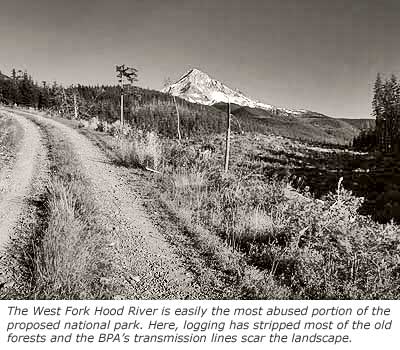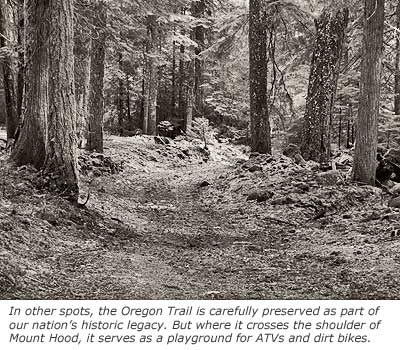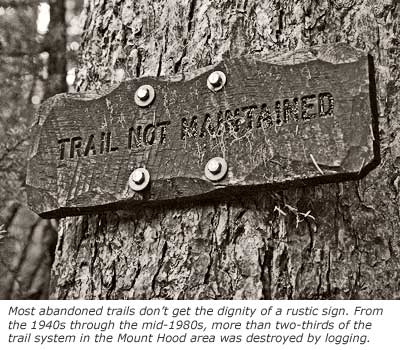
_________________________________________________________
What is the vision?
The Mount Hood National Park Campaign carries forward a century-old vision for protecting Mount Hood and the Gorge River Gorge. These four principles are an updated spin on the original vision:
1. Heal the Land - In the early days of the 1900s, the forests of Mount Hood were managed for watersheds and recreation, but by World War II, the emphasis had shifted to exploitation and the era of industrial logging. But by the early 1990s, over-cutting had pushed the logging program beyond anything resembling "sustainability" and today we are left with hundreds of miles of deteriorating logging roads, failing culverts and bridges and unhealthy forest plantations. While the situation is - in fact - dire, the forest is already trying to recover on its own. The national park proposal would help speed the healing by finally putting an end to the notion that the steep canyons and ridge tops of the Mount Hood area are suited to tree farming, and focus on long-term restoration of the forest ecosystem.
Hood area are suited to tree farming, and focus on long-term restoration of the forest ecosystem.
A first step in the healing is to decommission logging roads that do not serve a recreation or restoration purpose. This means removing culverts and tilling and re-seeding roads to prevent them from diverting storm water laterally across mountain slopes, a key contributor to increased erosion and slope failures.
Next, many of the softwood plantations must be commercially thinned in order to help restore the mixed stands that make up a healthy forest canopy. This will be a difficult step for the environmental community to accept, but is nonetheless necessary to prevent catastrophic fires and disease from devastating the logged portions of the forest.
Finally, a large area of private timber holdings must be brought into public ownership. The most notable among these are the West Fork Hood River tree farms of the Longview Fibre corporation, a Canadian subsidiary that turns Mount Hood's forests into cardboard boxes and kraft paper. Adding insult to injury, Longview dumps tons of herbicide onto the lands they've clearcut to prevent the natural succession of hardwoods that would otherwise help mountain soils recover by fixing nitrogen and curbing erosion -- but also delay the production of more softwoods as a crop to make more boxes with. Bringing these lands under public stewardship is essential to restoring the north slopes of Mount Hood.
2. Preserve the History - No other portion of the American West has seen the passage of human history quite like that which Mount Hood and the Columbia River Gorge have witnessed over the millennia. Mount Hood towered on the horizon where Native Americans dipped for salmon at Celilo Falls, and the great Table Mountain landslide in the Columbia Gorge gave birth to the Bridge of the Gods allegories carried forward by generations of native people. Native Americans revered Mount Hood, and harvested berries and other foods from its slopes for trade along the busy Columbia River travel corridor.
In the 1792, Lt. William Broughten, a member of George Vancouver's discovery expedition, named Mount Hood for a British admiral after seeing the white pyramid floating in the distance from their voyage up the Columbia River. In 1805, Lewis and Clark approached the peak from the opposite direction, and marvelled as it towered  above their route through the Columbia Gorge. These explorers opened the floodgates for tens of thousands of white settlers who would follow their paths through the Gorge, and later over the Barlow Road as it crested the south shoulder of Mount Hood.
above their route through the Columbia Gorge. These explorers opened the floodgates for tens of thousands of white settlers who would follow their paths through the Gorge, and later over the Barlow Road as it crested the south shoulder of Mount Hood.
In the 1900s, the pioneer roads were replaced with one of the world's first scenic byways - first with the Columbia River Highway, and later the Mount Hood Loop Highway. These routes brought tourists to the Gorge and Mount Hood in large enough numbers to warrant a string of lodges and roadhouses. Franklin D. Roosevelt traveled up the Hood River Valley in 1938 to dedicate the greatest lodge of them all at Timberline - a favorite product of his Civilian Conservation Corps and Works Progress Administration initiatives.
Today, the remnants of this long human history are preserved in a chaotic crazy quilt of small parks, museums and interpretive sites, and many bits of history are at risk of being lost for lack of funding and a cohesive vision for protecting the historic legacy. National Park status would bring a long-overdue awareness of what is at stake, and a vision for preserving the history of Mount Hood and the Gorge for future generations.
3. Restore Recreation - No other aspect of the various, conflicting missions of the U.S. Forest Service is more out of balance than the agency's response to growing recreational demands. This is in large part because the timber industry held the agency captive for more than half a century, to the extent that much of today's recreational infrastructure is actually a remnant from earlier in the 1900s, when campgrounds, trails, picnic areas, scenic drives and lodges were the focus of public stewardship.
Today's trail system is just one-third of the system that was in place in the early 1940s, thanks to decades of logging and road building. But there has also be a near absence of new campgrounds and other recreational facilities, despite rapid population growth in the adjacent Portland metropolitan area. During the next 25 years, the Portland region is expected to gain another million residents, a degree of growth that demand expandedrecreation opportunities. Thus far, the U.S. Forest Service has responded to these pressures by building larger parking lots at trailheads, and paving overused trails. But these are band-aid solutions, and fly in the face of their own research that shows a large majority of visitors to be seeking solitude and escape from urban pressures
Contrary to the U.S. Forest Service claims, there is plenty of money in the Mount Hood National Forest budget to pay for recreation. In fact, most national parks operate with much smaller budgets, so what explains the difference? In reality, the Forest Service has created its own dilemma with the decision to built elaborate networks of logging roads that now represent an enormous maintenance liability. An added expense is the engineering and administrative cost of continued logging, despite the fact that numerous studies have shown that the Forest Service timber programs are losing money, and are subsidized by the taxpayers.
The first step in restoring the recreation focus under the national park proposal is to greatly expand active recreation, including new trails, campground and picnic areas. The Forest Service likes to point to surveys that show use of these facilities declining, but in well-managed state and national parks in the region, the data shows just the opposite trend - as do the common sense measures of crowded trailheads and campgrounds that better meet public needs. It's time for Mount Hood and the Gorge to be competently managed for recreation, given the overwhelming growth in demand that will accompany the region's growth.
Another step in restoring balance to the recreation system will be a long-term vision for how the ski industry is managed on Mount Hood. To date, the Forest Service hasn't seen a ski resort expansion plan that it didn't like, and both the Timberline and Meadows resorts have spilled beyond their logical, natural boundaries to the detriment of the environment and other recreational activities. Curbing this trend will require a break from the "for profit" model that the Forest Service currently rationalizes resort expansion on, and instead, focus on how best to serve the public, while still protecting the scenic and natural legacy of the mountain.
4. Protect the Legacy - Beyond the specifics of how a Mount Hood National Park might be managed is the simple fact that the National Park Service has a clarity in their mission that the Forest Service can never have. While the Forest Service struggles endlessly to be everything to everyone, the Park Service clearly understands their mission to protect natural and cultural places, above all else. The Park Service also has a proven track record in restoration, something the Forest Service has aspired to, but never accomplished on a meaningful scale. In the end, the purpose of the Mount Hood National Park Campaign is to ensure that future generations will know and enjoy Mount Hood and the Columbia Gorge in the same way that we do in our time. Only the Park Service can meet that challenge, and the stakes are too great to allow for anything less.
